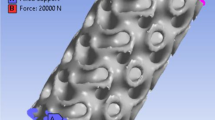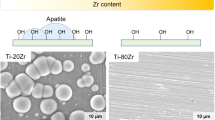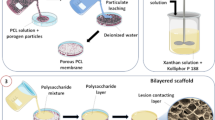Abstract
Biocomposite is extensively implemented in orthopaedics and dentistry since multiple materials blends can be utilised by capitalising on their radical compatibility. Bioactive glasses (BG) and β-tricalcium phosphate (β-TCP) have excellent bioactive, osteoconductive, and osteogenic features due to the resemblance of their inorganic constituents with bone or dental tissue. In this study, sol–gel BG was incorporated with β-TCP for potential application in dental tissue engineering. A 40/60 composition ratio of BG/β-TCP powder was homogeneously mixed in a zirconia planetary ball mixer and sieved to obtain particle size of less than 50 μm. The BG/β-TCP powder composite was characterised using X-ray diffraction (XRD), X-ray fluorescence (XRF), scanning electronic microscopy (SEM), laser diffraction particle size analyser, and in vitro biological characteristics were observed by soaking the BG/β-TCP composite in simulated body fluid (SBF) and exposing the Saos-2 cells towards conditioned medium. The XRD analysis identified the presence of whitlockite (ICCD 00–009-0169) and combeite (ICDD 96–900-7722) crystalline phase in the composite structure. The pH tends to be in the range of 7.7 to 8.0 throughout the study period, and SEM exhibited the hydroxyapatite (HA) formation on the surface after 1 day when immersed in SBF. Based on in vitro investigation, the BG/β-TCP composite presented enhanced cell adhesion and proliferation. In this preliminary study, in vitro HA formation ability, and cell proliferation properties may have considered the BG/β-TCP biocomposite as a potential for bone and dental tissue engineering.





Similar content being viewed by others
Data Availability
The datasets generated during and/or analysed during the current study are not publicly available but are available from the corresponding author on reasonable request.
References
Milton, G.W., Sawicki, A.T.: Theory of composites. Cambridge monographs on applied and computational mathematics. Appl Mech Rev. 56, B27–B28 (2003)
Mohanty, A.K., Misra, M., Hinrichsen, G.I.: Biofibres, biodegradable polymers and biocomposites: an overview. Macromol Mater Eng. 276, 1–24 (2000)
Molano, C.B.: Synthetic porous ceramic compared with autograft in scoliosis surgery. J Bone Joint Surg Br. 80, 747 (1998)
Bohner, M.: Calcium orthophosphates in medicine: from ceramics to calcium phosphate cements. Injury 31(Suppl 4), 37–47 (2000)
Yang, S.-Y., Piao, Y.-Z., Kim, S.-M., Lee, Y.-K., Kim, K.-N., Kim, K.-M.: Acid neutralizing, mechanical and physical properties of pit and fissure sealants containing melt-derived 45S5 bioactive glass. Dent. Mater. 29, 1228–1235 (2013)
Nagy, M.M., Tawfik, H.E., Hashem, A.A.R., Abu-Seida, A.M.: Regenerative potential of immature permanent teeth with necrotic pulps after different regenerative protocols. J Endod. 40, 192–198 (2014)
Wiegand, A., Buchalla, W., Attin, T.: Review on fluoride-releasing restorative materials—fluoride release and uptake characteristics, antibacterial activity and influence on caries formation. Dent. Mater. 23, 343–362 (2007)
Nejatian, T., Khurshid, Z., Zafar, M.S., Najeeb, S., Zohaib, S., Mazafari, M., Hopkinson, L., Sefat, F.: Dental biocomposites. In: Biomaterials for oral and dental tissue engineering, Elsevier, 65–84 (2017)
Chu, C., Xue, X., Zhu, J., Yin, Z.: Fabrication and characterization of titanium-matrix composite with 20 vol% hydroxyapatite for use as heavy load-bearing hard tissue replacement. J Mater Sci Mater Med. 17, 245–251 (2006)
Hesaraki, S., Safari, M., Shokrgozar, M.A.: Development of β-tricalcium phosphate/sol-gel derived bioactive glass composites: physical, mechanical, and in vitro biological evaluations. J Biomed Mater Res B Appl Biomater. 91B, 459–469 (2009)
Owen, R., Reilly, G.C.: In vitro models of bone remodelling and associated disorders. Front Bioeng Biotechnol. 6, (2018)
Chen, Q.Z., Thompson, I.D., Boccaccini, A.R.: 45S5 Bioglass®-derived glass–ceramic scaffolds for bone tissue engineering. Biomaterials 27, 2414–2425 (2006)
Ramlee, S.N.L., Sharifulden, N.S.A.N., Mohamad, H., Noor, S.N.F.M.: Sol-gel derived bioactive glass scaffolds incorporated with polyvinyl-alcohol and pluronic P123 polymers using sponge replication technique. Mater Today Proc. 17, 966–975 (2019)
Wei, L.J., Shariff, K.A., Momin, S.A., Bakar, M.H.A., Cahyanto, A.: Self-setting β-tricalcium phosphate granular cement at physiological body condition: effect of citric acid concentration as an inhibitor. J. Aust. Ceram. Soc. 57, 687–696 (2021)
Hill, R.G., Brauer, D.S.: Predicting the bioactivity of glasses using the network connectivity or split network models. J Non Cryst Solids. 357, 3884–3887 (2011)
Kokubo, T., Takadama, H.: How useful is SBF in predicting in vivo bone bioactivity? Biomaterials 27, 2907–2915 (2006)
Sepulveda, P., Jones, J.R., Hench, L.L.: In vitro dissolution of melt-derived 45S5 and sol-gel derived 58S bioactive glasses. J Biomed Mater Res. 61, 301–311 (2002)
da Silva, J.G., Babb, R., Salzlechner, C., Sharpe, P.T., Brauer, D.S., Gentleman, E.: Optimisation of lithium-substituted bioactive glasses to tailor cell response for hard tissue repair. J Mater Sci. 52, 8832–8844 (2017)
Chatzistavrou, X., Kontonasaki, E., Chrissafis, K., Zorba, T., Koidis, P., Paraskevopoulos, K.M.: Surface and bulk contributions in the crystallization process of a bioactive glass. Key Eng Mater. 309–311, 313–316 (2006)
Boccaccini, A.R., Chen, Q., Lefebvre, L., Gremillard, L., Chevalier, J.: Sintering, crystallisation and biodegradation behaviour of Bioglass®-derived glass–ceramics. Faraday Discuss. 136, 27 (2007)
Arstila, H., Fröberg, L., Ylänen, H., Hupa, L.: Sintering range of porous bioactive glasses. In: 7th Conference of the Europeans Society of Glass Science and Technology, Athens, Greece, (2005)
Peitl, O., Dutra Zanotto, E., Hench, L.L.: Highly bioactive P2O5–Na2O–CaO–SiO2 glass-ceramics. J Non Cryst Solids. 292, 115–126 (2001)
Chen, Q.-Z., Li, Y., Jin, L.-Y., Quinn, J.M.W., Komesaroff, P.A.: A new sol–gel process for producing Na2O-containing bioactive glass ceramics. Acta Biomater. 6, 4143–4153 (2010)
Jang, H.L., Jin, K., Lee, J., Kim, Y., Nahm, S.H., Hong, K.S., Nam, K.T.: Revisiting whitlockite, the second most abundant biomineral in bone: nanocrystal synthesis in physiologically relevant conditions and biocompatibility evaluation. ACS Nano 8, 634–641 (2014)
Driessens Verbeeck R. M. H., F.C.M.: Biominerals. CRC Press, Boca Raton (1990)
Peitl Filho, O., LaTorre, G.P., Hench, L.L.: Effect of crystallization on apatite-layer formation of bioactive glass 45S5. J Biomed Mater Res. 30, 509–514 (1996)
Du, R., Chang, J.: Preparation and characterization of bioactive sol-gel-derived Na2Ca2Si3O9. J Mater Sci Mater Med. 15, 1285–1289 (2004)
López Calvo, V., Vicent Cabedo, M., Bannier, E., Cañas Recacha, E., Boccaccini, A.R., Cordero Arias, L., Sánchez Vilches, E.: 45S5 bioactive glass coatings by atmospheric plasma spraying obtained from feedstocks prepared by different routes. J Mater Sci. 49, 7933–7942 (2014)
Nahar U, K., B, S., Chandra D, R., Chandra P, S., B, S., YM, M., Islam MD, S.: Characterization of beta-tricalcium phosphate (β- TCP) produced at different process conditions. J Bioeng Biomed Sci. 07, (2017)
Tan, C.Y., Singh, R., Teh, Y.C., Tan, Y.M., Yap, B.K.: The effects of calcium-to-phosphorus ratio on the densification and mechanical properties of hydroxyapatite ceramic. Int J Appl Ceram Technol. 12, 223–227 (2015)
Wang, H., Lee, J.-K., Moursi, A., Lannutti, J.J.: Ca/P ratio effects on the degradation of hydroxyapatitein vitro. J Biomed Mater Res. 67A, 599–608 (2003)
Calcium phosphates as substitution of bone tissues: VALLETREGI, M. Prog. Solid State Chem. 32, 1–31 (2004)
Baino, F., Vitale-Brovarone, C.: Three-dimensional glass-derived scaffolds for bone tissue engineering: current trends and forecasts for the future. J Biomed Mater Res A. 97A, 514–535 (2011)
Christie, J.K., Ainsworth, R.I., de Leeuw, N.H.: Investigating structural features which control the dissolution of bioactive phosphate glasses: beyond the network connectivity. J Non Cryst Solids. 432, 31–34 (2016)
Hill, R.: An alternative view of the degradation of bioglass. J Mater Sci Lett. 15, 1122–1125 (1996)
Jones, J.R.: Reprint of: review of bioactive glass: from hench to hybrids. Acta Biomater. 23, S53–S82 (2015)
Tilocca, A.: Structural models of bioactive glasses from molecular dynamics simulations. Proc Royal Soc A: Math, Phys Eng Sci. 465, 1003–1027 (2009)
Nawaz, Q., de Pablos-Martín, A., Martins de Souza e Silva, J., Hurle, K., Jaimes, A.T.C., Brauer, D.S., Boccaccini, A.R.: New insights into the crystallization process of sol-gel–derived 45S5 bioactive glass. J Am Ceram Soc. 103, 4234–4247 (2020)
Stanciu, G.A., Sandulescu, I., Savu, B., Stanciu, S.G., Paraskevopoulos, K.M., Chatzistavrou, X., Kontonasaki, E., Koidis, P.: Investigation of the hydroxyapatite growth on bioactive glass surface. J Biomed Pharm Eng. 1, 34–39 (2007)
Pang, Y.X., Bao, X.: Influence of temperature, ripening time and calcination on the morphology and crystallinity of hydroxyapatite nanoparticles. J Eur Ceram Soc. 23, 1697–1704 (2003)
Jones, J.R., Sepulveda, P., Hench, L.L.: Dose-dependent behavior of bioactive glass dissolution. J Biomed Mater Res. 58, 720–726 (2001)
Bingel, L., Groh, D., Karpukhina, N., Brauer, D.S.: Influence of dissolution medium pH on ion release and apatite formation of Bioglass® 45S5. Mater Lett. 143, 279–282 (2015)
Thomas, A., Bera, J.: Preparation and characterization of gelatin-bioactive glass ceramic scaffolds for bone tissue engineering. J Biomater Sci Polym Ed. 30, 561–579 (2019)
Acknowledgements
Sujon Mamun Khan has been honoured with a fellowship from the Universiti Sains Malaysia, and he wishes to express his gratitude to the university for the financial support it has given him throughout his studies.
Author information
Authors and Affiliations
Ethics declarations
Competing of interests
The authors declare no competing interests.
Additional information
Publisher's note
Springer Nature remains neutral with regard to jurisdictional claims in published maps and institutional affiliations.
Rights and permissions
Springer Nature or its licensor (e.g. a society or other partner) holds exclusive rights to this article under a publishing agreement with the author(s) or other rightsholder(s); author self-archiving of the accepted manuscript version of this article is solely governed by the terms of such publishing agreement and applicable law.
About this article
Cite this article
Sujon, M.K., Mohd Noor, S.N.F., Zabidi, M.A. et al. Combined sol–gel bioactive glass and β-tricalcium phosphate for potential dental tissue engineering: a preliminary study. J Aust Ceram Soc 59, 415–424 (2023). https://doi.org/10.1007/s41779-023-00841-7
Received:
Revised:
Accepted:
Published:
Issue Date:
DOI: https://doi.org/10.1007/s41779-023-00841-7




